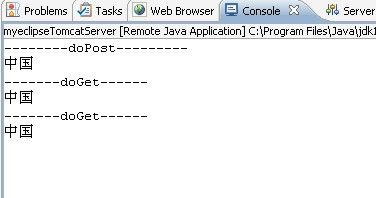关于处理客户端提交中文数据乱码问题解决对策
IT程序员开发必备-各类资源下载清单,史上最全IT资源,个人收藏总结!
例子程序:
对于html页面,控制客户端以什么编码打开页面,以及以什么编码将数据发送给服务器的语句:
<!DOCTYPE HTML PUBLIC "-//W3C//DTD HTML 4.01 Transitional//EN">
<html>
<head>
<title>MyHtml.html</title>
<meta http-equiv="keywords" content="keyword1,keyword2,keyword3">
<meta http-equiv="description" content="this is my page">
<!-- 对于html页面则是下面语句控制客户端以什么编码打开页面,以及以什么编码将数据发送给服务器 -->
<meta http-equiv="content-type" content="text/html; charset=utf-8">
</head>
<body>
This is my HTML page. <br>
</body>
</html>
对于html页面,控制客户端以什么编码打开页面,以及以什么编码将数据发送给服务器的语句:
<!-- 这里的pageEncoding属性的值指定了客户端以什么编码打开本页面,以及以什么编码将数据发送给服务器 -->
<%@ page language="java" import="java.util.*" pageEncoding="utf-8"%>
<%
String path = request.getContextPath();
String basePath = request.getScheme()+"://"+request.getServerName()+":"+request.getServerPort()+path+"/";
%>
<!DOCTYPE HTML PUBLIC "-//W3C//DTD HTML 4.01 Transitional//EN">
<html>
<head>
<base href="<%=basePath%>">
<title>My JSP 'encoding.jsp' starting page</title>
<meta http-equiv="pragma" content="no-cache">
<meta http-equiv="cache-control" content="no-cache">
<meta http-equiv="expires" content="0">
<meta http-equiv="keywords" content="keyword1,keyword2,keyword3">
<meta http-equiv="description" content="This is my page">
<!--
<link rel="stylesheet" type="text/css" href="styles.css">
-->
</head>
<body>
<!-- post提交中文数据 -->
<form action="encoding" method="post">
UserName:<input type="text" name="username"><br/>
<input type="submit" value="submit">
</form>
<!-- get提交中文数据 -->
<form action="encoding" method="get">
UserName:<input type="text" name="username"><br/>
<input type="submit" value="submit">
</form>
<!-- url提交中文数据 -->
<a href="encoding?username=中国">click me</a>
</body>
</html>
处理客户端三种提交"中国“中文数据的乱码问题处理方式:
package edu.request;
import java.io.IOException;
import java.io.PrintWriter;
import javax.servlet.ServletException;
import javax.servlet.http.HttpServlet;
import javax.servlet.http.HttpServletRequest;
import javax.servlet.http.HttpServletResponse;
public class EncodingServlet extends HttpServlet {
public void doPost(HttpServletRequest request, HttpServletResponse response)
throws ServletException, IOException {
System.out.println("--------doPost---------");
/**
* 乱码原因:
* 1.客户端会将encoding.jsp页面用户输入的"中国",以encoding.jsp的编码(这里是utf-8),将中文数据以utf-8进行编码
* 产生二进制数据发送给服务器,如在UTF-8字符集中"中国"的二进制数据(98,99)
* 2.Servlet处理程序默认会按照ISO8859-1字符集将二进制数据(98,99)编码为String数据,由于ISO8859-1字符集中98,99
* 对应的字符不是中国,所以会乱码。
* 解决办法:
* 1.通过指定Servlet处理request中数据的字符集,让Servlet按照指定的字符集,组合二进制数据即可,即使Servlet按照
* utf-8字符集重组获取参数的内容。指定方法如下:
* request.setCharacterEncoding("utf-8");
**/
request.setCharacterEncoding("utf-8");
String username = request.getParameter("username");
System.out.println(username);
}
public void doGet(HttpServletRequest request, HttpServletResponse response)
throws ServletException, IOException {
System.out.println("-------doGet------");
/**
* 乱码原因:
* 乱码原因和上面以post方式提交中文数据的乱码原因相同
* 解决办法:
* 1.由于 request.setCharacterEncoding("utf-8");只对以post提交的数据有效,对以get和url提交的数据无效,
* 其实url也是以get的方式提交数据的。
* 2.这里只能采用"先打碎再重组"的方式获取正确的中文数据,由于客户端提交的中文是按照utf-8打碎后,传给服务器,
* 而request.getParameter("username")取得的数据是Servlet按照默认的ISO8859-1字符集进行重组的,肯定是乱码的,所以应先按照ISO8859-1将request.
* getParameter("username")的数据打碎为字节,然后在按照utf-8将"客户端输入的按UTF-8打碎的字节"进行重组。
* 具体为new String()
*
**/
String username = request.getParameter("username");
username = new String(username.getBytes("iso8859-1"),"UTF-8");
System.out.println(username);
}
}
按从上往下顺序,先后输入”中国后“,控制台输出:

二、Servlet处理服务器向客户端响应的中文数据乱码问题
1.服务器端程序向客户端写中文数据--以字节流写入response对象中
//字节流输出中文乱码问题
public class OutputStreamServlet extends HttpServlet {
@Override
protected void doGet(HttpServletRequest req, HttpServletResponse resp)
throws ServletException, IOException {
//指定浏览器什么码表打开服务器发送的数据
//resp.setHeader("Content-Type", "text/html;charset=utf-8");//代码1
//resp.setContentType("text/html;charset=utf-8"); //代码2
OutputStream out = resp.getOutputStream();
String data = "中国";
/*
* 乱码分析:
* 将data数据以utf-8码拆分成字节数据,但是浏览器默认是按照gb2312码将response对象中的数据合并为字符数据,
* 所以就会出现乱码。
* 解决办法:
* 让浏览器以utf-8码来合并字节数据,有四种方法
* 1.设置response的头信息:如代码1和代码2
* 2.向浏览器写模拟头信息,如代码3:
* 3.单击浏览器"查看"-->"字符编码"-->"UTF-8" 改变页面显示的字符编码
*/
out.write("<meta http-equiv='content-type' content='text/html;charset=utf-8'>".getBytes()); //代码3
out.write(data.getBytes("utf-8"));
}
@Override
protected void doPost(HttpServletRequest req, HttpServletResponse resp)
throws ServletException, IOException {
doGet(req, resp);
}
}
2.服务器端程序向客户端写中文数据--以字符流写入response对象中
public class PrintWriterServlet extends HttpServlet {
//字符流输出中文乱码问题
public void doGet(HttpServletRequest request, HttpServletResponse response)
throws ServletException, IOException {
//设置response使用的码表,以控制response以什么码表向浏览器写数据。
response.setCharacterEncoding("utf-8");
//指定浏览器以什么码表打开服务器发送的数据
response.setHeader("content-type", "text/html;charset=utf-8");
//以上两句也可以用一句话代替
// response.setContentType("text/html;charset=utf-8");
String data = "中国";
PrintWriter out = response.getWriter();
out.write(data);
}
public void doPost(HttpServletRequest request, HttpServletResponse response)
throws ServletException, IOException {
doGet(request, response);
}
}